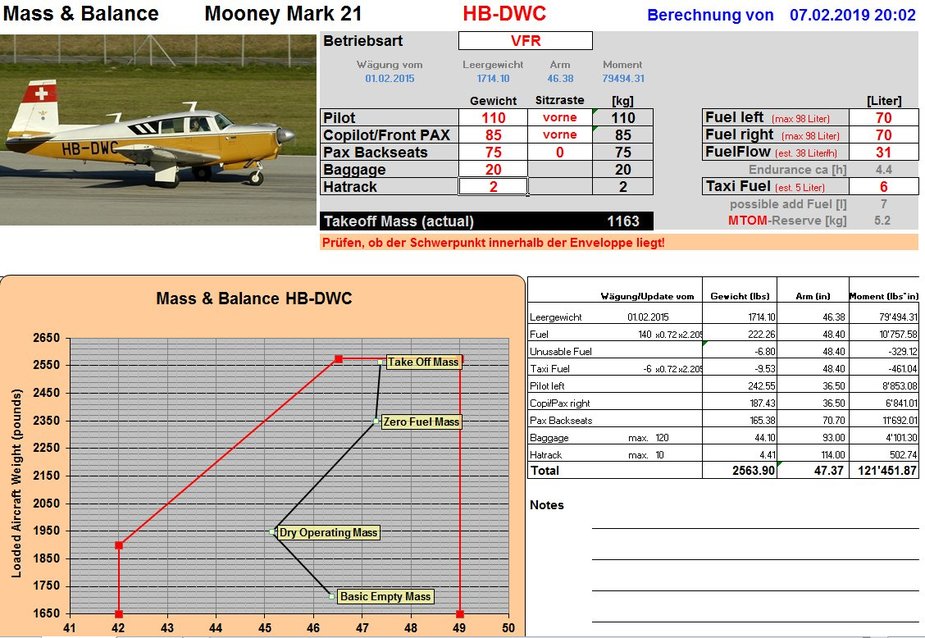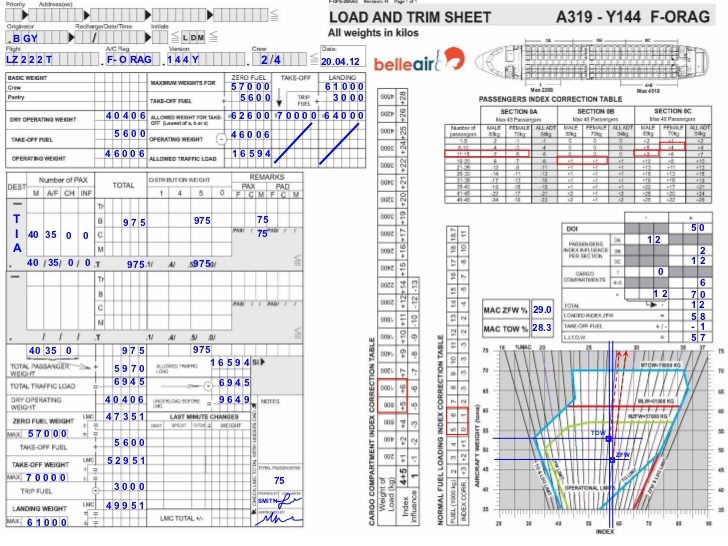I fly two seat side-by-side aircraft with seats, fuel tanks and small weight limited baggage compartments that are all not too far from the center of the CG range. I had a look at the W&B when I bought them to see what loading scenarios would take me to the limits, and filed that info away mentally. Having determined that my worst cases are all within the CG envelope, I now load based on weight. In these aircraft I will likely never have a written W&B report on hand and don’t expect to ever have an issue with that practice.
You can always rely on the Daily Trash to deliver a hilarious expose of certain echelons of society, and this is no exception. The poor AAIB would like to write this but would not dare:
No AOC for A-B charter (so, no insurance payout) unless of course he can swing it under the new cost sharing rules, but £1500 would take a PA28 to, hmmm, Luxor? 
Massively overweight aircraft.
641m grass.
From the above:
March 1, 2018: Greater Manchester Police said the pilot would face charges of flying without a licence, endangering the safety of an aircraft, endangering the safety of persons or property, failing to discharge responsibilities as pilot in command and failing to carry documents on a flight and answer charges of illegal public transport, flying otherwise than in accordance with the conditions or limitations contained in the aircraft flight manual and flying without insurance.
Mooney_Driver wrote:
But would you ask friends (particularly females) to step on a scale or even ask their weight?
Yes. If that’s a problem for them, they don’t fly. Mind, I do this in a friendly, but firm way.
In any case, at least in ForeFlight this is a calculation that can be accomplished in seconds if you’ve correctly set up your W&B for the airplane you fly. I have done so for the airplanes (four) I regularly fly.
Peter wrote:
Firefighters at the airport were so concerned they put on their protective clothing in anticipation of an emergency.
While this is of course hilarious in its own way, did nobody think of having a word, quiet or otherwise, with that guy?
On a different note – people pay 500 quid each to go birdwatching? There’s a business right there ! Not in a PA28, perhaps……
As a very young PPL holder I could tell you that the PA28-140 would lift about three people and fuel at Tabs, this was not an excuse to go flying without a W&B calculation but a good guess as to who you could invite to go flying and where you could go.
Contrast this with a guy who has owned flying clubs and puts four large people and full fuel into the same aircraft and expects it to fly, one has to ask what was going on in this guys mind?
While I could understand someone using very sharp pencil calculations to get the mission flown this flight was so far from safe from a performance point of view I can only think that greed overcame any regard for the laws of physics.
mh wrote:
Just answer him. Say, you’ve done it once and with 2 normal POB and full fuel, you can’t possibly overload an Archer or get it out of balance. EASA sais it doesn’t need anything written, so don’t.
So far I only had it once, I was asked to show my paperwork for the flight and put the briefing folder from Easy VFR on the table (horizontal stabilizer actually) and the excel loadsheet I always use. They leaved through it and that was it plus licenses and airplane papers, 5 mins flat. I then took the pax inside and came back out to cover the plane when another plane arrived and got the same questions asked. He had everything on Ipad and was asked to produce all the flight prep on the pad including WnB which they checked very carefully. I left before they were finished and it took me maybe 20 minutes to clean up and cover the airplane.
I once asked a guy at a safety forum who gave a lecture about ramp checking what they look for in WnB. He told me that they can tell from afar if someone is serious or not and if not, it can get up to the stage where they unpack a scale from their car and get down to business. So far, my paperwork has always been accepted by anyone who had to look at it, flight examiner for PPL checkride and the ramp check guys alike.
So I suppose no, you don’t need it but it comes in handy if you have it. Maybe as a former load controller I am simply too used to have them.

“I once asked a guy at a safety forum who gave a lecture about ramp checking what they look for in WnB. He told me that they can tell from afar if someone is serious or not and if not, it can get up to the stage where they unpack a scale from their car and get down to business”
An instructor gave me spreadsheet for W&B for a PA28 that had pax weight in stones, fuel in litres and baggage in kgs, poh MTOW was in lbs poh GC in inches,
I will make a print for my next ramp check somewhere where metric system is the norm unless the guy has a PhD, I don’t think he will find his way easily in those numbers, but will have a slick one like yours as backup if things get serious ;)
I’ve printed a W&B card for the Jodel DR 1050 with different fuel situations, and people weights. Usually I don’t calculate.
“An instructor gave me spreadsheet for W&B for a PA28 that had pax weight in stones, fuel in litres and baggage in kgs, poh MTOW was in lbs poh GC in inches,”
After a day flying with a Syndicate member who was a PhD professional mathematician, an ATPL who’d been flying at work approached, and after a chat, we considered flying together. Legality was uncertain, so we each calculated the C of G.
We had a mix of units to convert.
All three of us got different positions, all just legal. We recalculated, using another’s technique. We now had 6 different C of G positions.
We decided NOT to fly together.
Maoraigh wrote:
We now had 6 different C of G positions.
We decided NOT to fly together.
Best argument for a standardized and commonly used excel sheet for all I’ve heard so far.
My first aviation job was doing hand loadsheets for airliners. As I was flying already at the time (1986) I knew how to do loadsheets for small planes and found it increadible that it was far easier to do balance for an airliner than for a lousy Seneca or Cessna. I then looked at how the index based balance sheets worked and made one for the Seneca II I was flying at the time. It took 2 minutes to complete as opposed to 10 with a calculator the conventional way.
This is the kind of loadsheet we used to do in the days, could not find an original…

I used something VERY simple while instructing

This has to be prepared for a specific pilot. It takes into account whatever is most limiting, C of G or MTOW.
G-BNNY: with full fuel, I can put in one passenger in the front seat with up to 58kg before I hit the front C of G limit, or load it up with two passengers weighing a total of 129kg.
G-ENNA was much harder to get out of front C of G, and at tabs the only one you could get out of rear C of G before hitting MTOW was G-BSVM.
All that is needed is adding up the weights and a single glance.